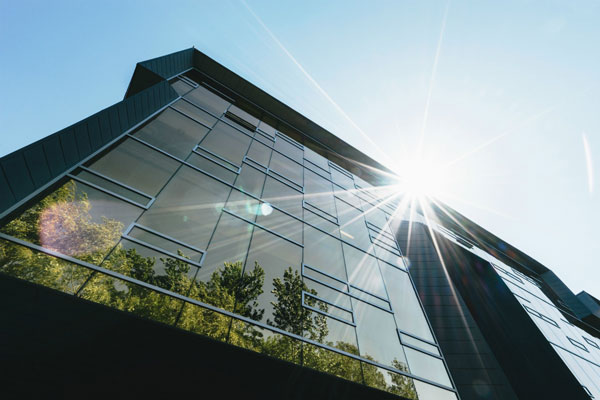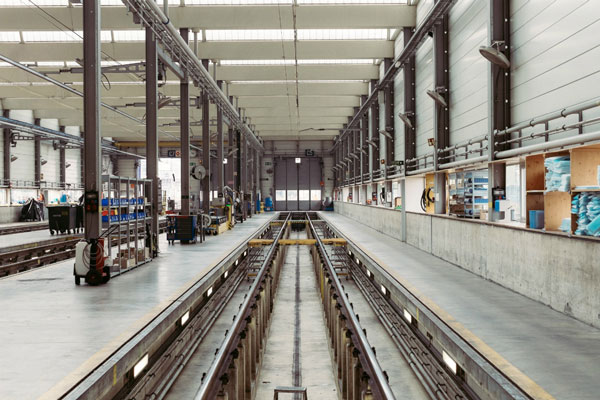
Sustainability is more than a lofty business goal. It has become a necessity for companies in response to the push for environmental stewardship in business practices. Combine sustainability with a business need to maximize budgets, and facilities managers often end up spearheading environmentally friendly programs that help a business save money.
One area that facilities managers should consider is lighting. Daylighting, the use of natural light to illuminate interior spaces, has become a popular strategy for companies that want to incorporate sustainable practices and reduce energy costs.
As Dan Calabrese points out at Area Development, natural light is “free, clean and infinitely renewable,” as well as being associated with more pleasant work environments. Engineer Paul Langford explains that studies have shown that exposure to natural light increases mental alertness, productivity and psychological well-being.
Though it may entail a large upfront cost, the investment in implementing natural light is worth it for businesses. As industry expert Brandon Tinianov at View, Inc. explains, people are an organization’s most valuable resource, and often its largest expense: For every dollar spent on energy, 10 dollars is spent on real estate and 100 dollars is spent on people.
But implementing natural light is not without challenges, especially in industrial buildings where there are unique concerns that must be addressed before daylighting can be introduced.

Benefits of Natural Light
As Kevin Van Den Wymelenberg notes at Architectural Lighting, daylit environments increase comfort and productivity for workers by providing the visual and mental stimulation that regulates circadian rhythms. These rhythms, as Christopher Bergland explains, are the result of natural factors within the body, though they are affected by environmental triggers such as light.
Companies that introduce natural lighting to their workplaces typically see improvements in employee health, have higher employee productivity and save money on energy costs.
Improved Employee Health
A study published in 2014, Impact of Workplace Daylight Exposure on Sleep, Physical Activity, and Quality of Life, concluded that workers with windows in the workplace received 173 percent more white light exposure during work hours and slept an average of 46 minutes more per night. Also, workers without windows reported lower scores on quality of life measures related to physical problems and vitality.
Workers with light exposure tended to have not only longer sleep duration but also better sleep quality, more physical activity during the day and a better quality of life than counterparts with less light exposure, the study concluded.
“There is increasing evidence that exposure to light, during the day — particularly in the morning — is beneficial to your health via its effects on mood, alertness and metabolism,” says senior study author Phyllis Zee, M.D., a Northwestern Medicine neurologist and sleep specialist. She noted their study confirmed that light exposure during the natural daylight hours has powerful health effects on workers.
Increased Productivity
Natural light has a positive impact on worker productivity through increased concentration and awareness, the team at Bristolite Daylighting Systems says. They note that people working in naturally lit spaces do not tire as easily and are more aware during the day, thereby making fewer mistakes in their work.
An article for Work Design Magazine highlights a few studies that show that good view quality and daylight in the workplace resulted in a 6.5-percent reduction in absenteeism for employees sitting closer to natural lights. Another study, The Human Spaces report into The Global Impact of Biophilic Design, reveals that office workers who are around natural elements, including light, are six percent more productive and 15 percent more creative than colleagues without access to these natural elements.
Energy Efficiency and Savings
The Whole Building Design Guide (WBDG) explains that electric lighting accounts for 35 to 50 percent of total electrical energy consumption in commercial buildings, and the waste heat adds to loads imposed on cooling equipment. The energy savings from the use of daylighting strategies can directly reduce cooling energy use by 10 to 20 percent and total energy costs by as much as 33 percent.

Challenges Of Daylighting in Industrial Facilities
Industrial facilities face a host of challenges when incorporating daylight. Glare and thermal heating as a result of daylighting can actually reduce worker productivity by creating uncomfortable working environments.
Industrial facilities are also concerned about the protection of privacy and maintenance issues, which is why so few have allowed for natural lighting. As LEED AP Jeffrey Kuhnhenn notes, companies don’t want equipment or processes visible to outsiders, and glass from windows and skylights becomes a maintenance and safety issue in buildings where dust and debris are produced.
Another concern for industrial facilities, according to Kuhnhenn, is water leakage that can seep through windows and skylights and contaminate products, disrupt processes and interact dangerously with other chemicals.
Solutions For Incorporating Natural Light
Daylighting can be especially helpful in industrial environments where natural light is often non-existent, presenting a prime opportunity for implementation. But as Kuhnhenn says, different solutions work for different facilities, so the first step is to take stock your facility, its processes and its needs before committing to any changes.
Here are three options that might be a good fit:
1. Windows and Skylights
Incorporating windows and skylights is the most popular option for introducing natural light into a building. But, for windows and skylights to be effective, they must be properly placed. The selection and placement of windows and skylights should be determined by the amount of light needed, regional climate, privacy requirements and the design of the building.
Larry Schoff, RBA/ESS, recommends introducing daylight as high as possible and using diffusers and glazing, which is especially useful for industrial facilities concerned with privacy, safety and glare. Cheryl Weber, LEED AP, explains that it’s important to place windows and skylights based on the sun’s movement as each placement affects heat transfer differently.
The design of the Miller SQA building in Holland, Michigan, incorporates skylights and windows throughout its 220,000 square feet of manufacturing space, allowing natural light to pervade the workspaces.

2. Tubular Daylight Devices (TDDs)
Tubular daylighting devices are a versatile alternative to traditional skylights because they can be used to provide light to areas that are not in a direct line of sight with the sun. TDDs use a rooftop dome to capture the sun’s light, which then travels through a reflective tube. Dana Carlson at SolaTube International explains that TDDs are more effective than traditional skylights or windows because of the reflective tubing, delivering maximum daylight with minimal heat transfer.
TDDs eliminate leakage issues because light is emitted through a small dome rather than a pane of glass. And because they are smaller, they can be installed without extensive renovation work.
Delta Gear, Inc. in Livonia incorporated TDDs into the design of their new facility. The building had two different roof types, and TDDs met the requirements for allowing light to permeate both.
3. Interior Design of Workspace
There are interior design tips and tricks that can enhance the natural lighting in a workspace, too.
WBDG notes that light reflectance should be kept as high as possible. They explain that the optimal reflectance for ceilings is 80 percent, walls more than 50 percent and floors around 20 percent.
LEED AR designer Jill Fehrenbacher suggests choosing light colors and reflective materials, like linoleum or polished wood. Houzz contributor Yanic Simard recommends choosing one color of paint for walls and ceilings. White is the best color to use because, as Simard explains, the color simulates full-spectrum natural sunlight while reflecting light.
Where you place workstations also matters, and simply redesigning workspace layout can increase workers’ access to natural light. The “Impact of Workplace Daylight Exposure” study referenced earlier concluded that the best place to put workstations is within 20 to 25 feet of peripheral walls that have windows.
Glass-partitioned walls and doors are also great for reflecting light. Kirco Manix took advantage of this natural-light emitting design principle during the renovation of its global headquarters in Detroit. All of the office spaces are glass-partitioned. The manufacturing facility also uses reflective floor surfaces, white walls and work-station placement to maximize daylighting.
It All Starts With A Plan
It is important that facilities managers spend time planning for the best solutions for their building. As Greg Zimmerman, executive editor at Facilitiesnet, explains, good daylighting can provide energy savings and more productive workers. However, bad daylighting can have the opposite results. Facilities managers must take the time to understand how light enters their buildings to create the most effective daylights controls strategy.
Credits:
Scott Webbdotshock
Breather
Samuel Zeller
